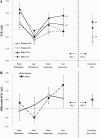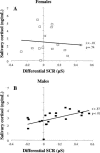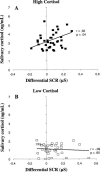Effects of stress and sex on acquisition and consolidation of human fear conditioning
- PMID: 16847304
- PMCID: PMC1538921
- DOI: 10.1101/lm.189106
Effects of stress and sex on acquisition and consolidation of human fear conditioning
Abstract
We examined the relationship between stress hormone (cortisol) release and acquisition and consolidation of conditioned fear learning in healthy adults. Participants underwent acquisition of differential fear conditioning, and consolidation was assessed in a 24-h delayed extinction test. The acquisition phase was immediately followed by an 11-min psychosocial stress period (arithmetic test combined with a public speech). Salivary cortisol was sampled at various time points before and after acquisition and retention of fear conditioning. Results showed two effects of endogenous cortisol. Post-acquisition cortisol correlated with fear acquisition in male but not female participants. In addition, post-acquisition cortisol correlated with consolidation of fear but only in those participants with high cortisol levels. We conclude that in the short term, a robust and sexually dimorphic relationship exists between fear learning and stress hormone levels. For those participants whose fear learning is accompanied by high stress hormone levels, a long-term relationship exists between cortisol release and memory consolidation. These short-term and long-term effects may relate to the differential involvement of mineralocorticoid and glucocorticoid receptor subtypes, respectively. The findings have implications for understanding the role of stress, sex, and hormones in different stages of fear learning and memory.
Figures





Similar articles
-
Sex, stress, and fear: individual differences in conditioned learning.Cogn Affect Behav Neurosci. 2005 Jun;5(2):191-201. doi: 10.3758/cabn.5.2.191. Cogn Affect Behav Neurosci. 2005. PMID: 16180625
-
Influence of stress on fear memory processes in an aversive differential conditioning paradigm in humans.Psychoneuroendocrinology. 2013 Jul;38(7):1186-97. doi: 10.1016/j.psyneuen.2012.12.018. Epub 2013 Jan 18. Psychoneuroendocrinology. 2013. PMID: 23333200
-
Immediate pre-learning stress enhances baseline startle response and fear acquisition in a fear-potentiated startle paradigm.Behav Brain Res. 2019 Oct 3;371:111980. doi: 10.1016/j.bbr.2019.111980. Epub 2019 May 27. Behav Brain Res. 2019. PMID: 31145979 Free PMC article.
-
Using unconditioned responses to predict fear acquisition, fear extinction learning, and extinction retention patterns: Sex hormone status matters.Behav Brain Res. 2024 Feb 29;459:114802. doi: 10.1016/j.bbr.2023.114802. Epub 2023 Dec 9. Behav Brain Res. 2024. PMID: 38081517 Review.
-
Sex differences in stress effects on emotional learning.J Neurosci Res. 2017 Jan 2;95(1-2):93-105. doi: 10.1002/jnr.23811. J Neurosci Res. 2017. PMID: 27870431 Review.
Cited by
-
Interactive influence of sex, stressor timing, and the BclI glucocorticoid receptor polymorphism on stress-induced alterations of long-term memory.Brain Cogn. 2019 Jul;133:72-83. doi: 10.1016/j.bandc.2018.05.012. Epub 2018 Jun 5. Brain Cogn. 2019. PMID: 29880220 Free PMC article. Clinical Trial.
-
Stress and glucocorticoid receptor-dependent mechanisms in long-term memory: from adaptive responses to psychopathologies.Neurobiol Learn Mem. 2014 Jul;112:17-29. doi: 10.1016/j.nlm.2013.09.017. Epub 2013 Oct 7. Neurobiol Learn Mem. 2014. PMID: 24113652 Free PMC article. Review.
-
Individual differences in valence modulation of face-selective M170 response.Emotion. 2009 Feb;9(1):59-69. doi: 10.1037/a0014487. Emotion. 2009. PMID: 19186917 Free PMC article.
-
The influence of acute stress on the regulation of conditioned fear.Neurobiol Stress. 2014 Nov 15;1:134-46. doi: 10.1016/j.ynstr.2014.11.004. eCollection 2015 Jan. Neurobiol Stress. 2014. PMID: 25530986 Free PMC article. Review.
-
Stress potentiates decision biases: A stress induced deliberation-to-intuition (SIDI) model.Neurobiol Stress. 2016 Feb 12;3:83-95. doi: 10.1016/j.ynstr.2015.12.006. eCollection 2016 Jun. Neurobiol Stress. 2016. PMID: 27981181 Free PMC article. Review.
References
-
- Abercrombie H.C., Kalin N.H., Thurow M.E., Rosenkranz M.A., Davidson R.J. Cortisol variation in humans affects memory for emotionally laden and neutral information. Behav. Neurosci. 2003;117:505–516. - PubMed
-
- Arbel I., Kadar T., Silbermann M., Levt A. The effects of long-term corticosterone administration on hippocampal morphology and cognitive performance of middle-aged rats. Brain Res. 1994;657:227–235. - PubMed
-
- Bartels M., De Geus E.J.C., Kirschbaum C., Sluyter F., Boomsma D.I. Heritability of daytime cortisol levels in children. Behav. Genet. 2003;33:421–433. - PubMed
-
- Beckwith B.E., Petros T.V., Scaglione C., Nelson J. Dose-dependent effects of hydrocortisone on memory in human males. Physiol. Behav. 1986;36:283–286. - PubMed
Publication types
MeSH terms
Substances
Grants and funding
LinkOut - more resources
Full Text Sources
Medical
